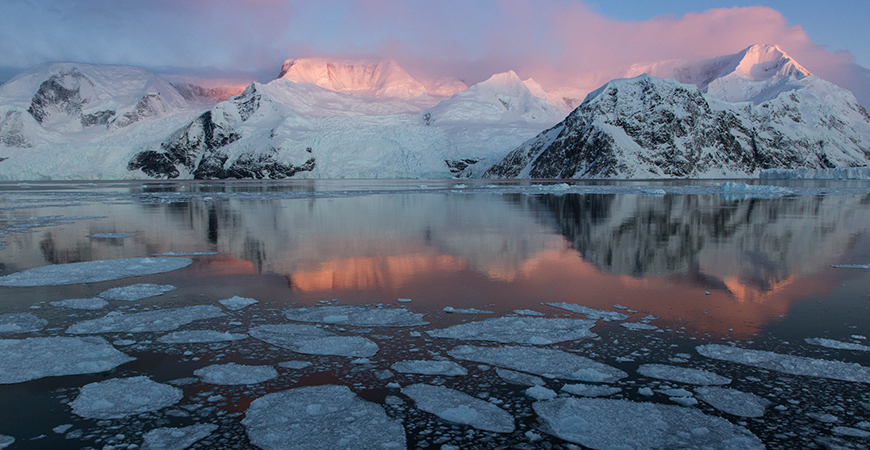Global S&T Development Trend Analysis Platform of Resources and Environment
| Special Notice: Scripps Oceanography Ecologist Statement on What's Next for Larsen C Iceberg | |
| admin | |
| 2017-07-14 | |
| 发布年 | 2017 |
| 语种 | 英语 |
| 国家 | 美国 |
| 领域 | 资源环境 |
| 正文(英文) |  Andvord Bay, Antarctica, recently explored by Scripps ecologist Maria Vernet. Photo: Maria Stenzel The calving of an iceberg from the Larsen C ice shelf is a natural occurrence, though the large size of this particular iceberg is unusual. In continuation of this process, the iceberg will be caught up in local currents and eventually drifts out of the region. Its gradual disintegration will change the ecological composition of adjacent waters. Ocean surfaces left in perpetual darkness when the ice shelf was intact will now be exposed to the atmosphere and sunlight. Photosynthesis will take place and biological activity will occur in areas where once there was none or very little. Icebergs laden with dust and sediments that they trapped when ice formed on land will seed new areas of the Weddell Sea and beyond with iron, nitrates, and other nutrients that will encourage primary productivity at the base of the ocean food web. For marine biologists and biological oceanographers, this is an important opportunity to understand the evolution of ecological systems that may accompany future trends in climate. – Maria Vernet, phytoplankton ecologist, Scripps Institution of Oceanography at the University of California San Diego Note to broadcast and cable producers: University of California San Diego provides an on-campus satellite uplink facility for live or pre-recorded television interviews. Please phone or email the media contact listed above to arrange an interview.
About Scripps OceanographyScripps Institution of Oceanography at the University of California San Diego, is one of the oldest, largest, and most important centers for global science research and education in the world. Now in its second century of discovery, the scientific scope of the institution has grown to include biological, physical, chemical, geological, geophysical, and atmospheric studies of the earth as a system. Hundreds of research programs covering a wide range of scientific areas are under way today on every continent and in every ocean. The institution has a staff of more than 1,400 and annual expenditures of approximately $195 million from federal, state, and private sources. Scripps operates oceanographic research vessels recognized worldwide for their outstanding capabilities. Equipped with innovative instruments for ocean exploration, these ships constitute mobile laboratories and observatories that serve students and researchers from institutions throughout the world. Birch Aquarium at Scripps serves as the interpretive center of the institution and showcases Scripps research and a diverse array of marine life through exhibits and programming for more than 430,000 visitors each year. Learn more at scripps.ucsd.edu and follow us at Facebook, Twitter, and Instagram.About UC San DiegoAt the University of California San Diego, we constantly push boundaries and challenge expectations. Established in 1960, UC San Diego has been shaped by exceptional scholars who aren’t afraid to take risks and redefine conventional wisdom. Today, as one of the top 15 research universities in the world, we are driving innovation and change to advance society, propel economic growth, and make our world a better place. Learn more at www.ucsd.edu.
|
| URL | 查看原文 |
| 来源平台 | Scripps Institution of Oceanography |
| 文献类型 | 新闻 |
| 条目标识符 | http://119.78.100.173/C666/handle/2XK7JSWQ/107547 |
| 专题 | 资源环境科学 |
| 推荐引用方式 GB/T 7714 | admin. Special Notice: Scripps Oceanography Ecologist Statement on What's Next for Larsen C Iceberg. 2017. |
| 条目包含的文件 | 条目无相关文件。 | |||||
| 个性服务 |
| 推荐该条目 |
| 保存到收藏夹 |
| 查看访问统计 |
| 导出为Endnote文件 |
| 谷歌学术 |
| 谷歌学术中相似的文章 |
| [admin]的文章 |
| 百度学术 |
| 百度学术中相似的文章 |
| [admin]的文章 |
| 必应学术 |
| 必应学术中相似的文章 |
| [admin]的文章 |
| 相关权益政策 |
| 暂无数据 |
| 收藏/分享 |
除非特别说明,本系统中所有内容都受版权保护,并保留所有权利。
修改评论